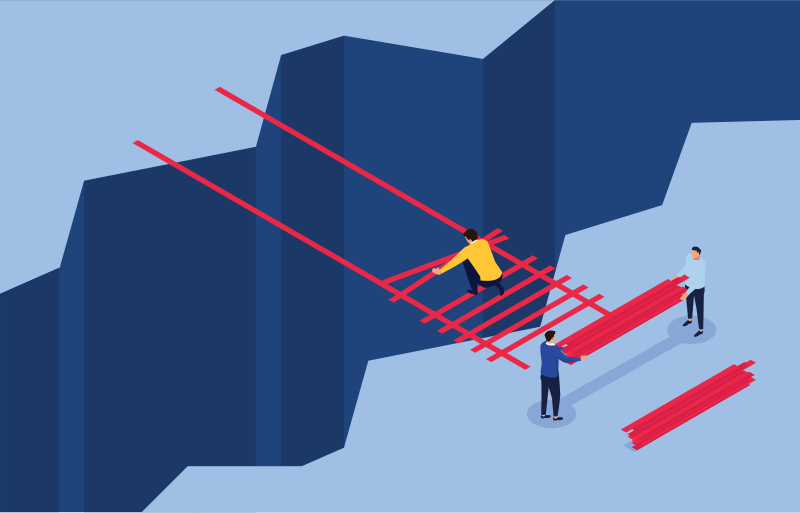If we know better, why don't we do better? Decades of research point to powerful practices that, if implemented well, could support better outcomes for all learners. Yet such practices—mastery teaching, formative assessment, and descriptive feedback come to mind—remain infrequently or inconsistently applied.
What keeps us from making better use of them? As it turns out, it's often the same factors that prevent use of evidence-based practices in other fields: ingrained habits, fleeting motivation, and a lack of peer supports. To help overcome these bad habits, leaders must recognize that implementation is not a single event. Organizations do not simply flip a switch from no implementation to full implementation. Rather, it's a process that reflects a series of predictable phases, which all take time and effort to nurture and sustain (Fixsen et al., 2009).
Phase 1: Identifying the Right Problem
The first phase of effective implementation, sometimes called the exploration phase, begins prior to implementation. A broad range of stakeholders—teachers, leaders, caregivers, and others invested in student success—develop shared understanding of the problem to solve and the need for better approaches and together determine how to tackle the problem (Fixsen et al., 2009). During this stage, it's important to explore many possible solutions before determining which is the best. For example, faced with low reading performance among 5th graders across its district, an improvement team might resist the urge to purchase a new reading curriculum and instead dig into data to better understand the problem and its root causes, while also exploring research on what has worked elsewhere. Only after that would they hypothesize a solution to implement and test.
Phase 2: Creating a Shared Vision
The next phase, called the installation phase (Fixsen et al., 2009), consists of laying groundwork for change by addressing what Bridges (2009) describes as the "4 Ps" of change: purpose (why the journey is necessary at this point in time), picture (what success will look at the end of the journey), plan (clarifying the steps to take), and part (the roles everyone must play for the effort to succeed).
Setting goals is also important during this phase. Goals should not be imposed on others, which leads to begrudging or perfunctory engagement. This phase should help stakeholders develop true intrinsic motivation to achieve shared goals, because, as decades of research shows, intrinsic motivators are far more powerful than extrinsic ones (Deci, Ryan, & Koestner, 1999).
Phase 3: Attending to Personal Transitions Early
Initial application of a new practice marks the most fragile stage of implementation (Fixsen et al., 2009). At first, new practices are bound to feel uncomfortable or inferior to old practices. It is at this point that organizations often experience what Fullan (2001) describes as an "implementation dip"—when fear of change collides with lack of know-how, and performance slumps.
To overcome implementation dips that may occur when new practices are introduced, school leaders need to maintain focus and urgency to quash any this-too-shall-pass syndrome, monitor the practices to ensure they are properly implemented, create an open dialogue (including listening to naysayers and considering adaptations as necessary), and encourage teamwork to buck one another up when the going gets tough. Perhaps most important, leaders must listen closely to people's thoughts, feelings, and worries.
For example, early in implementation of a new practice, some teachers may be reluctant to let go of familiar routines or resist feeling less competent. Leaders should talk through these concerns with teachers, remind them why change is needed, and assure them supports are available to them. Leaders should also anticipate that implementation of new practices will be uneven; some teachers may rapidly master and embed them into routines while others will need scaffolds—including modeling, coaching feedback, and opportunities for reflection (Hall & Hord, 2020).
Phase 4: Developing Communities of Practice
Years ago, Mary Budd Rowe (1986) discovered that teachers who had initially adopted better practices—in this case, "wait time" (three-second pauses after posing questions)—began backsliding to old habits (peppering students with rapid-fire questions) a few weeks later. It often goes like this with new practices—they take hold, but then begin to slip within months or weeks. In Rowe's research, she found the solution was to provide teachers with peer and coaching support.
Relying on supportive peers to sustain new habits has been found to work in other settings as well—including substance abuse counseling, helping parolees successfully re-enter society, and encouraging heart attack patients to sustain healthy lifestyle changes (Deutschman, 2006). In schools, the same principle applies: Full implementation requires working as teams to track progress, refine practices, and celebrate success (Hall & Hord, 2020).
Building the Bridge
Researchers have long described implementation as a bridge with current practice on one side of a ravine and desired outcomes on the other (Hall & Hord, 2011). If implementation plans are hastily drawn, the bridge may feel like a narrow, rope suspension bridge hung precariously over a canyon, which only the most adventurous (or foolhardy) will attempt to cross. With thoughtful planning and attention to each phase of the process, however, we can construct a bridge of steel and concrete that can help large groups of people cross the knowing-doing gap—not in one huge leap, but gradually, thoughtfully, and intentionally—together.



